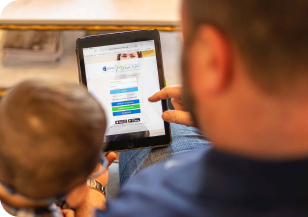GIVE NOW before 2025 ends—your gift will be doubled to help children in need. Click here to 2x your impact!

Ranked nationally in pediatric care.
Arkansas Children's provides right-sized care for your child. U.S. News & World Report has ranked Arkansas Children's in seven specialties for 2025-2026.

It's easier than ever to sign up for MyChart.
Sign up online to quickly and easily manage your child's medical information and connect with us whenever you need.

We're focused on improving child health through exceptional patient care, groundbreaking research, continuing education, and outreach and prevention.

When it comes to your child, every emergency is a big deal.
Our ERs are staffed 24/7 with doctors, nurses and staff who know kids best – all trained to deliver right-sized care for your child in a safe environment.

Arkansas Children's provides right-sized care for your child. U.S. News & World Report has ranked Arkansas Children's in seven specialties for 2025-2026.

Looking for resources for your family?
Find health tips, patient stories, and news you can use to champion children.

Support from the comfort of your home.
Our flu resources and education information help parents and families provide effective care at home.

Children are at the center of everything we do.
We are dedicated to caring for children, allowing us to uniquely shape the landscape of pediatric care in Arkansas.

Transforming discovery to care.
Our researchers are driven by their limitless curiosity to discover new and better ways to make these children better today and healthier tomorrow.

We're focused on improving child health through exceptional patient care, groundbreaking research, continuing education, and outreach and prevention.

Then we're looking for you! Work at a place where you can change lives...including your own.

When you give to Arkansas Children's, you help deliver on our promise of a better today and a healthier tomorrow for the children of Arkansas and beyond

Become a volunteer at Arkansas Children's.
The gift of time is one of the most precious gifts you can give. You can make a difference in the life of a sick child.

Join our Grassroots Organization
Support and participate in this advocacy effort on behalf of Arkansas’ youth and our organization.

Learn How We Transform Discovery to Care
Scientific discoveries lead us to new and better ways to care for children.

Learn How We Transform Discovery to Care
Scientific discoveries lead us to new and better ways to care for children.

Learn How We Transform Discovery to Care
Scientific discoveries lead us to new and better ways to care for children.

Learn How We Transform Discovery to Care
Scientific discoveries lead us to new and better ways to care for children.

Learn How We Transform Discovery to Care
Scientific discoveries lead us to new and better ways to care for children.

Learn How We Transform Discovery to Care
Scientific discoveries lead us to new and better ways to care for children.

When you give to Arkansas Children’s, you help deliver on our promise of a better today and a healthier tomorrow for the children of Arkansas and beyond.

Your volunteer efforts are very important to Arkansas Children's. Consider additional ways to help our patients and families.

Join one of our volunteer groups.
There are many ways to get involved to champion children statewide.

Make a positive impact on children through philanthropy.
The generosity of our supporters allows Arkansas Children's to deliver on our promise of making children better today and a healthier tomorrow.

Read and watch heart-warming, inspirational stories from the patients of Arkansas Children’s.

Hello.

Arkansas Children's Hospital
General Information 501-364-1100
Arkansas Children's Northwest
General Information 479-725-6800

Biopsy
A percutaneous biopsy is a procedure where an interventional radiologist uses ultrasound, x-ray or CT guidance to take a small tissue sample. This tissue is then given to a pathologist who looks at it under a microscope and makes a diagnosis. This is done through a single insertion site no bigger than a pencil tip.
Preparing for the Procedure
Most biopsies are performed under general anesthesia, which means that the patient must not have had anything to eat or drink in the 8 hours leading up to the procedure. Preprocedural imaging may be performed to assess where the area of interest is and the safest route. Pre-procedural labs will also be done in some cases, such as a blood count (hemoglobin and hematocrit).
During the Procedure
The patient will come into the interventional radiology suite or CT suite and be put under general anesthesia by our pediatric anesthesiologists. The patient will then be positioned on the table to give the interventionalist the safest route to perform the biopsy. Guided imagery will then be used to locate the targeted area. The skin and route will be numbed, and then under image guidance, the biopsy device placed into the target. Multiple samples will be taken at this point. These samples are anywhere from 1-3 cm long and about as thick as spaghetti. After the biopsy is complete, the area is re-imaged to ensure no immediate complications. A small amount of glue and a dressing are then placed over the insertion site.
After the Procedure
You can expect soreness in the region of the biopsy, similar to a deep bruise. This should last a couple of days and slowly improve with time. Tylenol or Motrin can be taken for any pain. Please refrain from any high-impact activities such as jumping or contact sports for 5-7 days after the procedure. Please do not submerge underwater for at least two days after the procedure. You may shower, but do not scrub the biopsy area. The doctor who ordered the procedure will reveal results a few days later (results can take anywhere from 2 days to a week).

